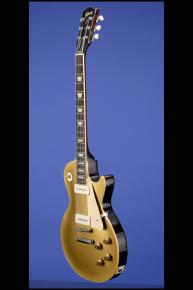An Exceptionally Fine and Totally Original 1956 "Dark-Back" Tune-O-Matic Les Paul Standard Gold Top
This totally original late Tune-O-Matic Les Paul Standard Gold Top weighs just 8.40 lbs. and has nice, fat nut width of just over 1 11/16 inches and a standard Gibson scale length of 24 3/4 inches. Solid "dark-back" mahogany body with a solid carved maple top, one-piece mahogany neck with a medium to thick profile, and rosewood fretboard with 22 medium to thin frets and inlaid pearl crown position markers. Headstock with inlaid pearl "Gibson" logo and "Les Paul Model" silkscreened in gold. Two-layer (black on white) truss-rod cover. The serial number "614034" is inked-on in yellow on the back of the headstock. The top of the guitar has single-ply cream binding and the fretboard has single white binding. Individual single-line Kluson Deluxe tuners with single-ring tulip-shaped Keystone plastic buttons (stamped on the inside "2356766 PAT APPLD"). Two nicely balanced P-90 pickups with outputs of 7.48k and 7.57k. The cream neck pickup cover is stamped on the inside "UC-452-F/1" and the cream bridge pickup cover is stamped on the inside "UC-452-B/2". Single-layer cream plastic pickguard. Four controls (two volume, two tone) on lower treble bout plus three-way pickup selector switch on upper bass bout. Gold plastic bell-shaped "Bell" knobs. The potentiometers are stamped "134 623" and "134 626" (Centralab June 1956). Two original "Bumble-Bee" capacitors (this is one of the first of the Lest Paul Standards to use "Bumble-Bee" capacitors—until 1956 they used "Grey Tiger" capacitors). ABR-1 non-retainer Tune-O-Matic bridge with metal saddles and separate "wrap-over" stud tailpiece. This fifty-year-old one of the very last of the P-90 Les Pauls is in exceptionally fine (9.00) condition. There is a small amount of belt buckle scarring on the back of the guitar, a few small marks or dings on the edge of the guitar, a little bit of edge wear on the lower edge of the guitar, some fine finish checking and a few very small marks on the top of the guitar, otherwise the top is very clean. The headstock is very clean and the back of the neck has just a few minuscule marks. The original frets do have some wear, mainly confined to the first five frets, but there is plenty of life left in them. There is no fading to the guitar whatsoever and the hardware is exceptionally clean. This is one of the lightest and best playing P-90 Les Paul Standards that we have ever seen. Housed in the original Gibson brown hardshell case with four latches and pink plush lining (8.75). This one owner guitar has the original brown leather strap, the original Gibson Sonomatic Strings hang tag, and a circa 1950's black and white photograph of the original owner playing the guitar with his band at some sort of holiday party.
"The first Gibson Les Paul solidbody electric guitar, known simply as the Les Paul Model then but now better known by its descriptive nickname 'gold-top', first went on sale during 1952" (Tony Bacon, 50 Years of the Gibson Les Paul, p. 15).
"The new Les Paul guitar was launched by Gibson in 1952, in the summer, priced at $210, which was about $20 more than Fender' Telecaster sold for at the time…Today, a gold-finish Les Paul model is nearly always called a gold-top thanks to its gold body face…The new gold-top's solid body cleverly combined a carved maple top bonded to a mahogany base, a sandwich that united the darker tonality of mahogany with the brighter sonic 'edge' of maple. Paul said that the gold colour of the original Les Paul model was his idea. 'Gold means rich,' he said, 'expensive, the best, superb'" (Tony Bacon, 50 Years of the Gibson Les Paul, pp. 20-21).
"In 1955 the gold-top gained Gibson's new Tune-o-matic bridge. The unit had the facility to adjust individual string-length, improving intonation. Two years later humbucking pickups replaced P90s on the gold-top" (Tony Bacon and Paul Day, The Gibson Les Paul Book, p. 19).
"Some 1957 and 1958 Les Paul goldtops are seen with dark brown backs. These 'dark backs' are easy to identify by the serial number, which is ink stamped with yellow ink (instead of black ink, as used on the light color backed goldtops). Also dark back Les Pauls will have black control cavity plates (as used on the Les Paul Custom) instead of brown plates" (http://www.provide.net/~cfh/gibson5.html). This guitar is a late 1956 Les Paul Gold Top—one of the very first "Dark Backs." It has the serial number stamped in yellow ink and has black control cavity plates rather than brown plates.
"The tone capacitors for (all) Les Paul models changed in late 1955. Prior to this they used a brown waxy looking tubular Sprague capacitor called the Sprague 'grey tiger'. But by 1956 this changed to Sprague's 'bumble bee' tube cap, which was black with colored value stripes (in the 1968 the same capacitor was again used on the single cutaway Les Paul standard reissues, but Sprague has changed the marketing name of the capacitor to 'Black Beauty'). The Bumblebee caps were used from 1956 until 1960 for all pre-SG Les Paul models (Juniors, Specials, Standards, Customs)" (http://www.provide.net/~cfh/gibson5.html).
Translate:









